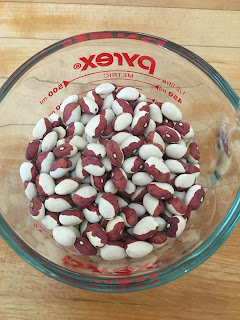 |
| Jota, with white beans, 2012 |
Now, eight years later, I have made jota for the second time. And I am a believer! It was wonderful. Comforting and zesty. It was a success mostly due to the limitations created by cooking in confinement.
The first big difference: Apache beans, which I had recently discovered work well as a substitute for borlotti or Roman beans in pašta fižol. In fact, if it weren't for that big bag of dried beans sitting in the pantry, I probably wouldn't have given jota another chance. I don't know what made the difference, the switch from white to red beans, or the fact that the beans were cooked from scratch this time. Probably both!
 |
| Apache Beans |
Oh-oh! Without really planning to, I had backed into making vegan jota! Now I was really facing a challenge. But a little online research revealed that my first recipe (from a non-Slovenian source) had been a particularly mild version, compared to the other approaches I was discovering. So I upped the garlic and added three new ingredients: tomato paste, paprika, and a touch of liquid smoke, the suggestion of a Slovenian vegetarian blogger.
These changes, growing out of a time of adversity, made all the difference. Even without the sausage, this version of jota was a winner. I can't wait to make it again!
Update: A month later (just after writing this post!) I was inspired to do it again, with one small change: Instead of sweet paprika, I used the hot smoked paprika I had recently bought. That created some added zest and it also eliminated the need for liquid smoke.
Jota, or Slovenian Bean and Sauerkraut Stew
1 cup dried borlotti, Roman, or Apache beans
2-3 medium potatoes (about 10 ounces cooked)
16 ounces sauerkraut
1-2 tablespoons olive oil
1 medium onion, cubed
4 cloves garlic, minced
1 tablespoon flour
2 bay leaves
2 tablespoons tomato paste (or catsup, in a pinch)
2-3 teaspoons paprika (sweet or smoked *)
salt and pepper to taste
2 cups potato water or other liquid
(Optional: 1/4 teaspoon liquid smoke, unless you use smoked paprika!)
Parsley to garnish
* To compensate for the absence of meat, consider using smoked paprika (preferred) or liquid smoke (which also works)
If desired: Smoked meat or sausage can be served on the side
If desired: Yogurt or sour cream (or a dairy-free alternative) to garnish
Prepare beans in the usual way: Soak overnight, simmer until tender, and drain. You should have about 2-1/2 cups of cooked beans. (Yes, you can substitute 2 cans of beans, although I don't recommend it!)
Cube the potatoes and cook in boiling salted water until tender. Save the water. Drain sauerkraut if you want a milder dish. (I didn't!)
Heat olive oil in a large pot and cook onions until softened. Add garlic, sprinkle with flour, and cook for several more minutes, stirring constantly until mixture turns golden. (Yes, you are making a roux, just like the Cajuns!) Add a little water to this mixture and stir to make a sauce. Add the tomato paste, the remaining seasonings, the sauerkraut, and additional liquid as needed. Simmer the mixture for 10-15 minutes. Add the cooked potatoes and beans and simmer for 20 more minutes. At the end, taste the seasonings and adjust.
To serve, garnish with parsley, plus yogurt or sour cream if desired. Sausage or other meat can be served alongside.





